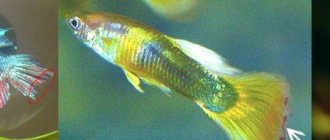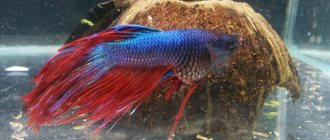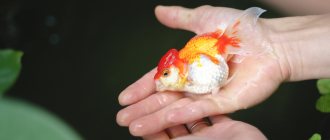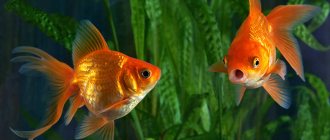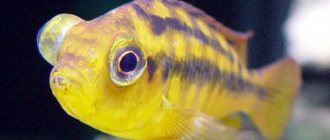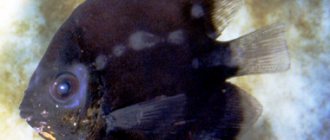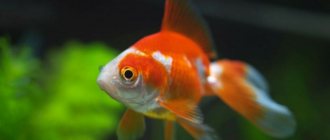- Disease Prevention
- Fin rot
- Ichthyophthiriasis (semolina)
- Treatment of fish with saline solution
- Exophthalmia (bulging eyes)
- Dropsy
- Oodiniosis: stuck together fins
- Columnaria
- Video - fish diseases (bettas)
Have you noticed in the pet store plastic containers with brightly colored fish with huge fins, gracefully swimming among algae and castles? This is the most beautiful species of fish called Betta splendens, also known as betta fish. Aquarists adore these fish, because they are easy to care for, but they are prone to various diseases.
Proper care, attentiveness, and compliance with a number of rules will help you avoid illnesses of your beloved pets and prolong life expectancy. Knowing what diseases a betta fish can develop and their signs, you can be calm about the health of your pet, which will delight you with its beauty and incredible grace for many years.
In this article, experts will tell you what diseases of betta fish exist and how to treat them. So, let's go.
Disease Prevention
These lovely fish suffer from bacterial and parasitic diseases. It’s easy to understand that your pet is sick: the fish hides at the bottom, refuses to eat, becomes covered with plaque and white spots, the color changes, and the fins are affected.
Let's figure out what causes diseases in betta fish:
- Poor water quality (fraught with decreased immunity and death of fish);
- Expired, low-quality food (immediately remove uneaten food);
- Garbage. Depending on the capacity of the aquarium, you need to regularly clean the aquarium once a week and change about 1/3 of the water;
- Insufficient filtration;
- An excess of pets in one container;
- Plants from other bodies of water;
- Impossibility of spawning (females get cancer, males become lethargic);
- Avitaminosis.
Important! Monitor the expiration dates of the food and do not overfeed the fish (you can find out the exact amount of food from the staff). An excess of food, as well as a lack of it, negatively affects the underwater beauties with sweeping fins.
Have you noticed the same symptoms in several fish? Check and change the water, install additional aeration, carry out the disinfection procedure. It’s worse if only one of the fish is sick: this indicates the onset of a bacterial disease, fraught with negative consequences. Let's figure out what diseases of aquarium betta fish occur and find out the main symptoms.
Causes of infection
Some of the most beautiful representatives of labyrinth fish are susceptible to various parasitic and bacterial diseases. You can tell that a betta fish is sick by its changed behavior. Sick fish stay in the low-lying layers of the reservoir, swim on their sides or belly up, and refuse to feed. White spots are noticeable on the body, plaque may appear or the color of the scales may change. In infectious diseases, the dorsal and caudal fins are affected. With fungal infections, sick fish are usually covered with a light, bluish coating.
Main causes of infection:
- unfavorable water parameters in the aquarium (temperature, pH);
- violation of diet, poor quality feed;
- unfavorable conditions of detention;
- lack of aeration, problems with water filtration;
- a large amount of “garbage” in the ground;
- violation of the rules of care.
Infection is facilitated by a large concentration of aquarium inhabitants per liter capacity. Bacteria can be introduced with soil, aquatic plants, or new fish that were introduced into the aquarium.
If disease symptoms appear to the same extent in most fish species, we recommend checking the parameters of the aquatic environment. If behavior has changed in a certain type of fish, this most likely indicates a bacterial infection.
Let's look at the main diseases of betta fish and their symptoms. Here are effective ways to treat them.
Fin rot
The cause is the bacterium Pseudomonas, which got into the water along with food or new inhabitants. Usually it clings to young or weakened individuals, but if detected untimely, it can destroy the entire population of the aquarium.
The symptoms are:
- Lethargy.
- Sudden change in color.
- Ulcers or bluish plaque on the body.
- Cloudiness of the cornea.
- Blowing bubbles;
- Ugly, drooping, stuck together fins.
Have you noticed one or more signs of fin rot? Begin immediate treatment, and until complete recovery, quarantine the sick fish, otherwise it will infect other pets.
Most often, specialists treat betta fish with streptocide or another antibacterial agent. Thus, treating betta fish with metronidazole gives a quick effect and improved health.
In addition, you can use special products sold in pet stores.
In addition, treatment can be carried out with the following drugs:
- Bicillin-5 (penicillin substance with bactericidal action).
- Biomycin (general purpose antimicrobial antibiotic).
- Malachite green. Treatment is carried out for a maximum of five days (gradually increasing the dosage from 0.5 to 0.7 ml). Only freshly prepared solution is used, the processing process takes five hours.
- Violet K (chlorohydrite). The substance is diluted in proportions of 0.1 grams per liter. Having applied 15 ml of solution, add it to 15 liters of water and pour it into the aquarium.
Antibiotics are given for a couple of months (the norm is 20 grams per 100 liters).
Remember that illnesses in fish occur very quickly: sometimes the clock literally counts. If you doubt the correctness of the diagnosis, you should contact a veterinary clinic or the staff of the Underwater World pet store, who will suggest the ideal medications and help you choose the required dosage.
Costiosis in cockerels
Costiosis is a difficult disease with a possible fatal outcome, the occurrence of which is provoked by a flagellar parasite. It clings to the cockerel with flagella and provokes the development of the disease.
Costiosis occurs when fish come into contact with an infected individual, as well as when the soil is poorly cleaned.
Several symptoms of bone disease can appear at once:
- mucus secretion and damage to the skin;
- the fins stick together, the gills become covered with a layer of mucus;
- the fish swims on its side and loses its appetite;
- The cockerel begins to rub against the walls.
When costosis occurs, it is necessary to resettle the infected males by first diluting 5 g of potassium permanganate in water. You can carry out prevention with baths using methyl blue, bicillin and trypaflavin.
Ichthyophthiriasis (semolina)
Have you noticed nodules or white bubbles on the body of the fish, reminiscent of lumps of semolina? Your pet is unhappy with the temperature of the water or the dirt, so she has contracted an infection caused by the ciliate ichthyophthirius. The signals are:
- Lack of appetite.
- Slow breathing;
- Impaired coordination of movements.
- Decreased activity.
- Weight loss.
In addition to bicillin-5 and trypaflavin, it is worth treating your betta fish in a salt bath.
Attention! Don’t think that just adding table salt will make the bacteria disappear. The recommended proportions must be carefully observed: non-compliance with the technology and excessive saturation of the solution lead to the death of the cockerel.
Jumps out of the water
Explanations for this behavior:
- Activity, fighting character, research instinct.
- Fear, stress factors (turning on the light, sudden loud sounds, hitting the aquarium, the appearance of a cat or dog, etc.). The fish leave the container in an attempt to hide.
- The round shape of the aquarium enhances external sounds.
- Lack of space.
- Water pollution.
- Malfunction of electrical appliances leading to electric shock to the fish.
- Aggressive tank neighbors.
- Improper water change, and as a result a sharp change in environmental conditions. The fish is trying to leave it and return to its previous conditions.
- Endo- and ectoparasites that irritate pets. Treated with medication.
Treatment of fish with saline solution
Treatment is carried out as follows:
- We transplant the cockerels into a separate container.
- Take pure salt and dissolve it in warm water (2 tablespoons of sodium chloride per 10 dm3).
- Turn on the aerator for 20 minutes.
- We launch the fish (if they lie sideways, you need to dilute the mixture).
Often this medicine for betta fish is enough to cure any infectious diseases.
It is important that there will be no benefit from one time: such treatment should be carried out in courses over a period of two weeks to a month. In a favorable situation, treatment of betta fish with chloramphenicol brings instant results.
Swells the gills
- The cockerel does this when winning a place in the hierarchy of the flock, and also before a fight.
- The male shows off in front of the female during the breeding and spawning periods, demonstrating his coloring and size.
- Illness associated with a bacterial or viral infection. Accompanied by ruffled scales, lethargic behavior, loss of appetite.
Note: owners often explain the swelling of the gills by a lack of oxygen in the water and install a compressor. This is not required. Bettas are labyrinth fish, they get oxygen from the atmospheric air.
Exophthalmia (bulging eyes)
If you notice a change such as bulging eyes in betta fish, it is a viral infection that is treated with Epsom salt (magnesium sulfate) and Ammonia-minus treatment.
The surface of the eye becomes cloudy, wrapped in a white film, the eyes can pop out of their sockets: in the most severe case, the cockerel will lose its organs of vision and die.
If you notice that the cockerel fish has become sad and its eyes have become white, take action (a favorable outcome depends on the timely detection of the disease). Replace the water, reduce food intake - if the source is improper conditions, then the swelling of the eyes will go away quickly.
These measures did not help, other infected people began to appear with a gray coating on their bodies and difficulty breathing? Place them in a plastic container, use ointments and antibiotics.
Preventive measures
A disease is easier to prevent than to cure. Prevention methods:
- Buying fish, plants, decor, soil in pet stores.
- Quarantine of new pets.
- Use of prophylactic medications.
- High quality food.
- Optimal maintenance conditions - temperature, lighting, filtration, aeration.
- Preventing overpopulation.
- Timely placement of fish in quarantine with symptoms.
It is recommended to stock up on medications in advance - buy medications from leading manufacturers with detailed instructions for use in the 12 Monkeys store.
Dropsy
If you notice that your betta fish has a swollen belly, treatment will be effective only at the very beginning of the disease. Dropsy is a very serious disease. There can be many reasons for the occurrence, it is important to find the source in time and promptly seek diagnostics from specialists. You can independently determine it by the following signs:
- Enlarged belly.
- Red spots at the base of the fins.
- Refusal to eat.
- Bruises on the body.
- Swollen eyes.
- Fast weight loss.
Important! In most cases, the source is a bacterial infection contracted while digging in the ground. Pay attention to the ammonia content in the water and inappropriate diet: as a result of unscrupulous care, the pet may die. If you notice a symptom such as constipation in your betta fish, treatment should be started immediately!
Keep in mind that in such a situation, complete disinfection and replacement of decorative elements, plants and other attributes are necessary.
Signs
Fluffy growths, usually white or whitish, sometimes large, looking like tiny tufts. They appear in places of wounds or where the integrity of the skin has been compromised due to diseases, including wounds left by large parasites. Untreated fungal growths can turn gray to reddish-brown over time as dirt and algae accumulate. If this condition is neglected, the fungus can gradually spread to adjacent healthy tissue. Severe cases can ultimately lead to the death of the fish. The fungus often appears as a secondary infection, including on the fins in the case of fin rot.
Oodiniosis: stuck together fins
With “velveteen disease,” the main manifestation is the presence of a light yellow coating on the body. There are other characteristic features:
- Breaking and splitting scales.
- Loss of color brightness.
- Apathy.
- Labored breathing.
- Drooping fins.
Appears as a result of poor care, hypothermia, or the introduction of individuals who have not undergone quarantine.
Antibacterial agents are used for treatment:
- Antipar (an antiseptic that affects fungus).
- Seraoodinopur (water condenser).
- Formamed (a drug against invasive diseases and maintaining a healthy environment).
- Ichthyofo (a substance based on two septic tanks: formalin and malachite green).
Please note: if at least one individual is unwell, it is necessary to carry out complete disinfection and treatment of the rest. Otherwise, the underwater beauties will infect each other, and the disease will drag on indefinitely.
During quarantine, maintain an elevated water temperature.
Cloudy or bulging eye(s)
- Reaction to dirty, cloudy water, with a large number of chemicals. This occurs as a result of the decomposition of food debris and waste products. It is necessary to test the medium for nitrites, nitrates, ammonia, and replace 25% of the water with clean, settled water.
- Incorrect water parameters. It is necessary to bring them to normal: hardness – 5-15 gH, acidity – 6-7.5 pH, temperature – 27-31°C.
- Microbacteriosis (tuberculosis).
- Aeromonosis, pseudomonosis. Treated with antibiotics.
Columnaria
If the cockerel is swollen near the gills, most likely there is an “oral fungus” that appears due to overcrowding, high concentration of organic matter, and untimely feeding.
The disease can be detected by the following signs:
- Lethargy.
- The desire to hide in a secluded place.
- Dark coating on the gills.
- Mouth damage.
- The appearance of cloudy fluid in the eyes.
Treatment of fungus in betta fish begins with the use of complex remedies, the use of disinfectants, and baths with phenoxyethane. Some people suggest adding methylene blue or Merbromin to promote faster healing.
Have you noticed that one or more pets are not feeling well? Now you know what diseases a cockerel can catch, and you can easily select the appropriate medications.
Unable to diagnose the disease? There are many photos on the Internet that help you establish and select effective treatment during consultation with specialists.
The cockerel fish is sick. I overfed and my stomach was swollen. On the forum they said not to feed for five days.
Tasha Tasha
The fish appears to have an obstruction, not an infection. You can't feed her. Cockerels cannot be fed with flakes alone; they must be given live food, otherwise they will have digestive problems. The fish will most likely die. Read about keeping fish, your size is too small, changes are rare, and the diet is most likely incorrect. Hence the illnesses and shortened life span.
Roman Leakishev
There is no need to mock a living organism. The fish is simply SHOCKED!!! Such a small volume and such frequent changes of water should have killed it long ago. I'm surprised at her survivability. I can advise you to leave her alone for a couple of days in a dark place and not even look there - let her come to her senses, and then a 30-liter aquarium with grass, without air supply, and read the literature, there is a lot of it now, especially on the internet.


